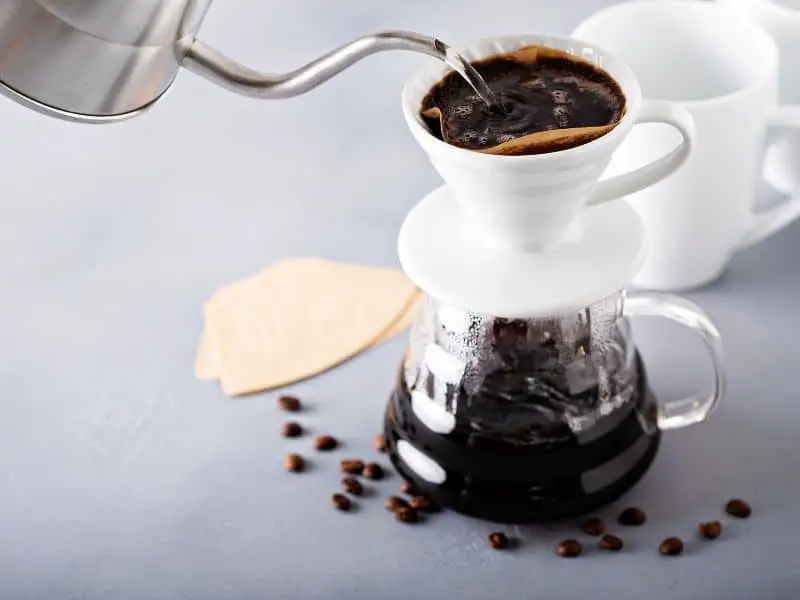Manually brewing your coffee has become a popular way for many to get their fresh morning brew.
When making pour-over coffee, you get to control the timing, distribution of the water, and the number of coffee grounds used, which makes for a delicious cup of coffee.
You may be wondering how you can make a flavourful brew at home with the pour-over method. And that’s what we’re going to look at in this article, how to make pour-over coffee at home.
Let’s get started.
What is pour-over coffee?
Pour-over coffee is coffee that is made by pouring hot water over coffee grounds in a filter.
The water drains through the coffee filter into a carafe or a mug.
A unique aspect of pour-over coffee that many coffee enthusiasts love is that when making pour-over coffee, you hand pour the water over the coffee.

Pour over vs French press
You may be wondering what the difference between a pour-over and a French press is. Although these methods both involve manually pouring hot water over the coffee, there are a few key differences that set them apart.
When making coffee with a french press, you put coffee grounds into a carafe, pour in hot water, let it steep and push down the plunger to separate the coffee.
Like with using a French press, making pour-over coffee involves manually pouring hot water over coffee grounds.
The main difference between these two methods is that with the pour-over method, the coffee grounds stay in a filter, and don’t seep into the finished brew.
Pour-over coffee is typically weaker than a french press although both coffees have a delicious flavor.
Chemex vs Pour over
Since Chemex is a type of pour-over coffee, they both bear many similarities.
Both Chemex and pour-overs use a paper filter to filter coffee, have a funnel-shaped top for the filter and coffee grounds, and are easy to use. There are a few distinct differences that set these two brewing methods apart.
An important difference between Chemex and a pour-over is in their filters. Pour-over filters are thin with pointed bottoms which draw the coffee into the cup once brewed. A Chemex filter is much different from that of a pour-over filter.
Chemex filters are only sold by the brand, Chemex and are thick, fabric-like, and are the shape of a large square folded into quarters.
The thickness of the Chemex filter works to remove the oil out of brewing coffee, which removes any bitter taste, giving your cup of coffee a bright, distinct flavor.
The Chemex also uses a much more coarse grind while pour-over filters use a fine grind.
Lastly, a Chemex is traditionally more expensive than a pour-over, and the filters for a Chemex can be twice as expensive as those of a pour-over. If you’re looking to stay within a budget, pour-over coffee is the best option for you.
How much coffee do you need for a pour-over?
If you’re looking to brew the perfect cup of pour-over coffee, you’ll want to know how much coffee to use when making yourself a cup of coffee.
Two scoops, or 30 grams of coffee beans, is the average amount of coffee to use for a single cup of pour-over coffee.
Once you make your first cup of coffee, you can experiment with the amount of coffee you use to find an amount that’s just right.
What is the best grind for pour-over?
When making pour-over coffee, a medium-coarse grind is an ideal grind to use.
A medium-coarse grind will be similar to that of the grind used in a French press grind, but it will be smoother.
If your pour-over is cone-shaped, a medium-fine coffee grind will work best.
How to make pour-over coffee
Making pour-over coffee can be done in a few simple steps.
- Bring 20 oz of water to a boil.
- Grind 30 grams of coffee to a medium-coarse grind. Your coffee grounds should resemble sea salt.
- Place a filter into the dipper
- Add the ground coffee into the filter and gently tap the filter to level out the coffee grounds.
- Place the brewer onto a carafe or cup.
- Put your brewer and cup onto a digital scale and set it to zero.
- Set a timer and carefully pour water slowly over the coffee. Start at the outer rim of the grounds and move in a spiral toward the center of the grounds.
- Once the scale reaches 60 grams, stop pouring and make sure all of the grounds are saturated in water.
- Wait for 30 seconds, then pour a steady spiral starting from the center of the grounds toward the outer edge, and back to the center.
- Add 90 grams of water – your total should be 150 grams. Wait 45 – 65 seconds.
- Pour 100 grams of water in the same way as you did during the second pour until your scale reads 250 grams.
- Once the water seeps to the bottom of the filter, add 100 grams of water until you have 350 grams.
- Your coffee is ready – enjoy your fresh brew!
Final thoughts on making pour-over coffee at home
Brewing pour-over coffee at home is a great way to get your morning caffeine fix while enjoying the process of making your coffee.
With just a few simple tools and some practice, you can make a delicious cup of pour-over coffee that will rival what you can get at your favorite cafe.
So why not give it a try? It’s easier than you think.

